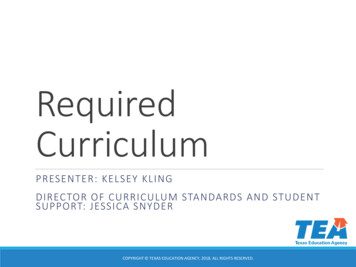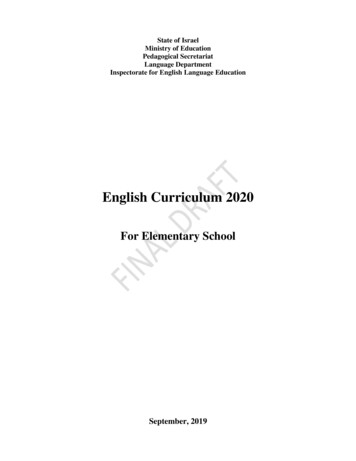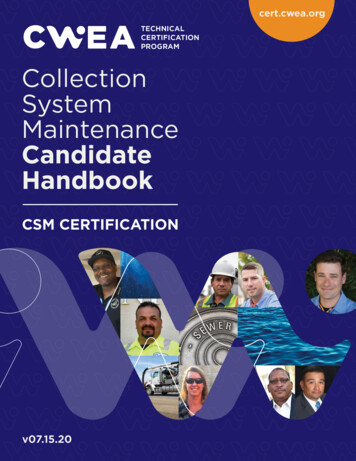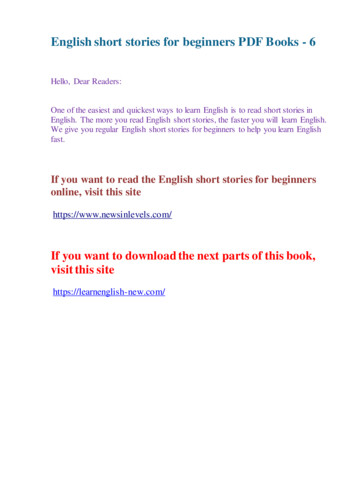
Transcription
DOCUMENT RESUMECE 039 631ED 248 351TITLEINSTITUTIONPUB DATENOTEPUB TYPEEDRS PRICEDESCRIPTORSEducation CurriculumBusiness English, VocationGuide. Bulletin 1722.Louisiana State Dept. of Education, Baton Rouge. Div.of Vocational Education.Apr 84'310p.GuidesClassroom UseGuides (For Teachers) (052)MF01/PC13 Plus Postage.Behavioral Objectives; *Business Communication;Business Correspondence; *Business Education;*Business English; Classroom Techniques;Communication Skills; Competence; EducationalStrategies; Grammar; Guidelines; InstructionalMaterials; Job Search Methods; Job Skills; *LanguageUsage; Learning Activities; Lesson Plans; ListeningSkills; Office Occupations Education; ProgramImplementation; Secondary Education; SkillDevelopment; State Curriculum Guides; TeachingMethods; *Technical Writing; *Writing SkillsABSTRACTThis curriculum guide consists of materials for usein teaching a course in business English for high school students.Addressed in the individual units of the guide are the followingtopics: the fundamentals of communication, listening skills, oralcommunications, telephone communications, information resources,reading and vocabulary, the mechanics of writing, grammar and usage;business reports, business letters and memos, and employmentprocedures. Each unit contains the following: an introduction, a listof competencies, general performance objectives and goals, specificperformance objectives and mastery criteria, methodology guidelines,suggested approaches, a unit outline, specific performance objectivesand learning activities relating to the outline, evaluation andtesting information, as well as one or more appendixes containingexercises, a unit test, answers to the unit test and lists ofresources and supplementary materials. ***************************Reproductions supplied by EDRS are the best that can be made**from the original ******************************
U.S. DEPARTMENT OF EDUCATIONIITU TE OF EDUCATIONNATIONA/ORMATIONEDUCALEN/. It .f HU.BUSINESS ENGLISHiioioduced asY/Trlis(1.''Itpriti.morqamtat)onOrigina (Inc; its.Moriorrsi Pie to it-ovumr.!prodiJi ho'Polots ofth,strriistrif official MEown! do 1).1 tisPOS,i101. or ;11y"PERMISSION TO REPRODUCE THISBYMATERIAL HAS BEEN GRANTEDVOCATIONALEDUCATION5qritTO THE EDUCATIONAL RESOURCESINFORMATION CENTER (ERIC,."Bulletin 1721/ CURRICULUM GUIDEDEPARTMENT OF EDUCATIONTHOMAS G. CLAUSENState Superintendent2
STATE OF LOUISIANADEPARTMENT OF EDUCATIONc.BULLETIN 1721BUSINESS ENGLISHIssued byOffice of Vocational EducationElaine P. Webb, Ed.D.Assistant SuperintendentThomas G. Clausen, Ph.D.State SuperintendentApril, 1984
STATE BOARD OF ELEMENTARY AND SECONDARY EDUCATIONCongressional DistrictMemberMr. Jesse H. BankstonDr. John A. BertrandBr. Felician Fourrier, S.C., PresidentMr. Milton HamelMrs. Gloria J. HarrisonMrs. Martha Scott HenryDr. Claire R. Landry, Vice PresidentMr. Jack PellegrinMr. A. J. "Sookie" Roy, Jr.Br. David Sinitiere, F.S.C.Mrs. Marie Louise Snellings, ge1st3rd8th2nd5thEQUAL OPPORTUNITY S1ATEMENTThis is an Equal Opportunity Institution and is dedicated to a policy ofnon-discrimination in employment or training. Qualified students,applicants or employees will not be excluded from any course or activitybecause of age, race, creed, color, sex, religion, national origin, orqualified handicap. All students have equal rights to counseling andtraining.This public document was published at a total cost of 4.39;2,000 copies of this public docut nt were published in thisfirst printing at a cost of 8,782.57. The total cost ofall printings of this document, including reprints isThis document was published by 'Louisiana 8,782.57.Department of Education, Office of Vocational Education,Post Office Box 44064, Baton Rouge, Louisiana 70804 for thedissemination of vocational education curriculum materialsfor new and changing occupational fields under authority ofPublic Law 94-482. This material was printed in accordancewith the standards for printing by state agenciesestablished pursuant to R.S. 43:31.
TABLE OF CONTENTSFOREWORDivACKNOWL:DGEMENTSBUSINESS ENGLISH CURRICULUM WRITING TEAMviiiINTRODUCTIONBUSINESS ENGLISH TIME SCHEDULEINSTRUCTIONAL UNITSFUNDAMENTALS OF COMMUNICATION, UNIT III-1.LISTENING SKILLS, UNIT IIIII-1ORAL COMMUNICATIONS, UNIT IIIIV-1TELEPHONE COMMUNICATIONS, UNIT IVV-1INFORMATION RESOURCES, UNIT VVI-1READING AND 'VOCABULARY, UNIT VIVII -1MECHANICS OF 'WRITING, UNIT VII.VIII -1GRAMMAR AND USAGE, UNIT VIIIIX-1BUSINESS REPORTS, UNIT IXX-1BUSINESS LETTERS AND MEMOS, UNIT XEMPLOYMENT PROCEDURES, UNIT XII-1.XI-1tii
FOREWORDThis curriculum guideline, Business English, was produced as aresult of a project funded by the Louisiana State Department of Education'to the Rapides Parish School Board.These units were developed with theassistance of Business Education teachers throughout the state ofLouisiana and have been subjected to formal field testing and evaluation.The instructional units of work included in this curriculum guidehave been written to aid teachers in meeting the increasing and changingneeds of the student and of the job market.This guide lists performanOeobjectives designed to enable students to reach practical learning goalsthat directly relate to communication frequently required in the businesssetting.(-(CA-A.A.A.,-THONAS C. CLAUSEN
ACKNOWLEDGEMENTSThis puolic:ation represents Oe cooperative efforts of personnel inthe Rapides Parish School Board and the.Business Education Section in theoffice of Vocational Education, Louisiana State Department of Education.Special recognition goes to Mrs. Ernestine Bridges who served as ProjectDirector and Mrs. Kayren Richardson who served as Project CurriculumSpecialist in the development of the guide.Special commendation goesalso to members of the writing team who worked so diligently to make thispublication a reality.Elaine Webb, Ed.D.Assistant SuperintendentOffice of Vocational Educationiv
BUSINESS ENGLISHCURRICULUM WRITING TEAMMrs. Ernestine Bridges, Project DirectorDirector of vocational EducationRapides Parish School BoardP.O. Box 123071301Alexandria, LAMrs, Kayren Richardson, Project Curriculum SpecialistVocational Curriculum SpecialistRapides Parish School BoardP.O. Box 123071301Alexandria, LARESEARCH ASSISTANTSAnn BarrettCrowley High SchoolRoute 270526Crowley, LA(318) 783-8058Patsy BlackBossier High SchoolColeman StreetBossier City, LA 71111(318) 222-9424Shelly BroussardVocational-Technical Center18th StreetLafayette, LA 70501(318) 233-2620JoAnn CalhounWest Monroe High School201 Riggs StreetWest Monroe, LA 71291(318) 323-3771Velma ClarkJena High SchoolP.O. Box 8971342Jena, LA(318) 992-5195Clemence DevereauxJohn ttDonogh Sr. High School2426 Esplanade AvenueNew Orleans, LA 70119(504) 821-7543 821-6479Annabell DoughtySummerfield High Sr;hoolP.O. Box 158Norma QuellBrusly High School630 Frontage RoadBrusly, LA 70719(504) 749-2815Summer field, LA(318) 927-362171079Debra DuplechinSouth Cameron High SchoolP.O. Box 10Creole, LA 70632(318) 542-4628Libby FabreSlidell High SchoolP.O. Box 78870459Slidell, LA(504) 643-2992
Julian GrayCarroll High School2939 Renwick StreetMonroe, LA 71201(318) 387-8441Gina GuzzinoPatterson Senior High SchoolP.O. Box 39870392Patterson, LA(504) 395-2675Rosa JacobsPeabody Magnet School2727 Broadway Avenue71301Alexandria, LA(318) 448-3457Nelwyn LabruzzoCentral Lafourche. High SchoolP.O. Box 89Mathews, LA 70375(504) 532-3319Barbara Matthews LoweWoodland HighAmdte, LA 70422(504) 748-8541Peggy MtKenziePine High SchoolRoute 2, 8ox 50Franklinton, LA 70438(504) 848-5243Ann ttKinnyMcKinley Senior High School800 East McKinley StreetBaton Rouge, LA 70802(504) 344-7696Freddie Jo NicholsBolton High School2101 Vance Avenue71301Alexandria, LA(318) 448-3628Jonnie V. QueenWest Monroe High School201 Riggs StreetWest Monroe, LA 71291(318) 322-0365Williah RandlesBolton High School2101 Vance Avenue71301Alexandria, LA(318) 448-3628Nell RayTerrebonne HighP.O. Box 276770361Houma, LA(504) 879-4847Jane RichardPort Barre High SchoolP.O. Box 69Port Barre, LA 70577(318) 585-7751Stephanie SmithBelle Chase High School215 Belle Chase Highway23 North Street70037Belle Chase, LA(504) 394-2810Mayne S. StrangeMansfield High SchoolKings Highway.71052Mansfield, LA(318) 872-0793Dorothy SwayzerWinnsboro High School1600 Clover Drive71295Winnsboro, LA(318) 435-5676Mary B. TerryAssulption High SchoolP.O. Box 33870390Napoleonville, LA(504) 369-2956Route 3,Box 309-Jvi
Martha TillLinville High SchoolLinvf11e, fA 71257(318) 292-5506Mae VernonPonchatoula High SchoolAnx 445Ponchatoula, LA 71454(504) 386-3514 386-3629Rome VeulemenSabine Parish School BoardP.O. Box 1153Many, LA 71449(318) 256.9228Dorothy WheelerBastrop High School402 Highland AvenueBastrop, LA 71220(318) 281-0194Grant WhiteTallulah High SchoolBayou DriveTallulah, LP 71282(318) 574-4747Norma B. WhiteCatahoula Parish School BoardP.O. Box 308Jonesville, LA 71343(318) 339-9505Mercedes WilliamsDavidson High SchoolP.O. Box 408St. Joseph, LA71366(318) 766-3585
INTRODUCTIONThe Business English curriculum guide developed by the Louisiana StateDepartment of Education emphasizes all components of communication- listening. speaking, writing. and reading. The performance objectiveswere designed to enable students to reach practical learning goals thatdirectly relate to communication frequently required in the businessSome of che goals deal with simple, yet vital concepts oftensetting.overlooked because it is assumed students are already competent Li thoseThroughouttextbooks.Writing is emphasized in Business Engareas.Allunitsrequirethe year, the curri.;ulum guide emphasizes writing.writing assignments to demonstrate understanding or application of theconcepts in the unit. Listening and speaking skills are often thought toAs a relult, generally little space in textbooks isdevote'' to these skills. However, the Business English curriculum guidees that listening and speaking skills should be part of literacyemph,Most textbooks devote little time to reading in the businesstraining.develop naturally.setting, but the Business English curriculum guide outlines manytechniques to teach the reading skills required on t!',o job.Since grarm3rand writing mechanics are dealt with in depth in Business Englishtextbooks, the curricular committee did not attempt to create materialsfor those units.The guide contains 'a unit outline that also serves as an informationThe outline is not meant to ilply that the recorded informationis exactly what must be taught. The purpose of the outline is to clarifymeaning of objectives that might not be clear, to supply information whereschool textbooks might be weak, and to organize information to facilitateoutline.easy presentation for the teacher.An appendix contains learningSomeactivities developed to facilitate teaching concepts in each unit.units have a sample list of "Related Terms" that could be introduced as aThese are terms that might naturally be used whilev)cabulary lessor).discussing concepts in each unit. This would give students practice inusing the terms within natural oral contexts, which is the best way forindividuals to learn new woras.Although each component of communication requires its own skills, thereare many fundamental concepts that are common to all modes of communicaUnit I, "Fundamentals of Communication," introduces the concepts comtion.mon to all areas of communication; therefore, it was placed first in thecurriculum guide. Fundamentals of communication will be strengthened andreinforced because the curriculum guide interrelates all the concepts inListening, oral communications, and readingoccupy a greater percentage of communication time than writing in our dailyeach area of communication.lives; therefore, these units were placed beore the report writing andletter writing units. Placing listening skills, oral communications, andreading early ir, the guide was further justified because skills and concepts introduced in those units can be continually addressed and emphasizedwithin the context of all the remaining units in the Business EnglishWithin each unit, specific performance objectives were organizedcourse.in a sequence so that successive items build on previous ones.viii11
The intentofthe short writing asc.fonmentsineach unit is to give stu-dents practice in formulating a thesis and supporting it with facts,details, or examples.This experience will prepare the students forwriting the business reports assigned in Unit IX. Although the units ongrammar, usage, and writing mechanics were placed in the middle of tnecurriculum guide, this does not mean that these skill.; should be ignoreduntil reaching that point in the curriculum. Grammar, usage, and writingmechanics should be addressed all year in writing assignments. Errc,,rcshould be marked, ind students should be encouraged to correct thoseerrors. Formal review of those concepts, however, was delayed until UnitsVII and VIII to allow first the introduction of the fundamental concepts oflistening, oral communications, and reading.Students will be evaluated by their performance on writing assignments, oral exercises, role-playing, written exercises, textbook and supIn each unit, the curriculum guideplementary exercises, and unit tests.This isidentifies questions from the unit test as learning activities.to emphasize that the learning process for each unit should not stop when"the students complete the unit test. Some concepts should be retaught.v.,luating writing assignments, it is important that students getIncredit for what they did right, such as writing a clearly stated thesis,adequately supporting the thesis, or using connecting signals skillfully.Too often students' writing assignments are marked only for errors ingrammar and mechanics. A successful method of showing students theirstrengths as well as their weaknesses is recording two grades for eachwriting paper--one grade for structure and development of the topic andthe other grade for grammar and mechanics.Make unit information pertinent by relating past, present, and futureMake assignments pertinent by relating to the students thelearning.purposes of the assignments and th? occasions on which they would applyTo ensure students' growth in writing, it is importantthe knowledge.that sufficient class time be spent in preparation for each writingexperience. The best results are observed after a topic is thoroughlydiscussed and students have had an opportunity to examine models thatdemonstrate the kind of development expected in the writing assignment.Teachers are encouraged to require study is to turn in a brief outlinebefore they complete their essays to assdre that the students organizetheir ideas before they begin writing. This requirement is equivalent toThe appendixesrequiring students to show their work in math classes.developed to go with the learning activities were created as sampleTeachers are encouraged to alter the exercises or developexercises.their own materials which will reflect their particular styles ofTeachers will particularly want to create their own lists ofteaching."Related Terms."
AUSIMSS ENGLISHTIDE SChEDULE'TimeUnit2 weeksFurdamentals of Communication2 weeksListeni,Ig Skills3 weeksOral Communications2Telephone Communicationsreeks2 weeksInformation Resources3 weeksReading and Vocabulary3 weeksAtchanics of Writing3 weeksGrammar and Usage6 weeksBusiness Reports6 weeksBusiness Letters and Memos4 weeksEmployment Procedures
UNIT IFUNDAMENTALS OF COMMUNICATIONINTRODUCTIONPoor per sonal relations is the most common reason for workers beingfired; therefore, it is understandable that getting along with employersand co-workers is considered the most important job skill. Getting alongwith others depends on a person's understanding of the principles of communicati)n and the psychology of communication. Choosing the right wordsto convey a message is not always easy.The right word can decide the difference between winning goodwill or creating a misunderstanding.The power gained through use of communication psychology, sometimescalled word magic, can be used to persuade, mislead, or confuse people whodo not understand the symbolic function of words and cannot use that knowledge to protect themselves. Human relations cannot be taught effectivelywithout addressing barriers to communication and the psychology of humanThe concepts related to psychology and human relations are oftenneeds.hard to pin down, but students will nsed concrete examples of communication psychology. Some of the best examples of language strategies, whichare applications of communication psychology, are found in advertising,propaganda, and political campaigns.This unit is designed to help the student discover that language is aprocess of encoding and decoding which is complicated by the fact thatwords do not carry with them exact meanings. Instead, words have shadesof meaning that are affected by the background and experiences of theencoder and decoder.Because of the shades of meaning, different peopleinterpret the same messages differently. Students should recognize thatthe shades of meaning of words and the use of language strategies playimportant roles in human relations.COMPETENCIES1.Recognize barriers to communication and take steps to overcome them.2.Use language strategies to promote goodwill and understanding incommunications.3.Anticipate needs and feelings of others and apply the "you" approachto business communications.4.Recognize levels of diction appropriate for business writing.I-114
GENERAL PERFORMANCE OBJECTIVES/GOALS1.Understand. the factors involved in the two-way process of communication.2.Recognize that the factors which create different meanings of wordsalso create barriers to communication.3.4.Recognize types of language strategies and develop skills in languagestrategies to promote goodwill and understanding.Understand basic human needs and recognize the significant role ofbasic human needs in communication psychology.5.Develop an awareness of the needs and feelings of individuals.6.Develop an awareness of levels of diction.SPECIFIC PERFORMANCE OBJECTIVES AND MASTERY CRITERIA1.1On a written test, students will explain the communication barriers in the two-way process of communication by graphically representing the process and by describing the factors that interferewith communication.1.2 On a written test students will identify terms related to the two-way process of communication by matching each term to itsdefinition.2.1On a written test, students will demonstrate "meaning is rot inthe word" by selecting two words and writing five statements usingeach word.2.2On a written test, students will distinguish between connotationand denotation by matching each term to its definition.2.3In a writing assignment to explain how langwTe is constantlychanging, students will describe factors that cause language tochange and give examples of words affected b, y each factor.2.4In a writing assignment to explain that euphemisms oppose "theword is not the thing," students will describe how eupheidsms areused and relate examples of euphemisms that demonstrate thatpeople react to words as if "the word were the thing."2.5In a writing assignment to explain why the factors that give meanings to words can be barriers to communication, students willdescribe factors that give words meanings and relate how these factors contribute to the barriers to communication.3.1On a written test, students will identify ,the meaning of verbalstrategies by matching the term to its definition.1-2
3.2 On a written test, students will demonstrate ability to use verbalstrategies by writing tt-ree sentences that show approval and threesentences that show disapproval.3.3In a writing assignment to explain how verbal strategies can beused to persuade or confuse, students will relate an example ofa verbal strategy that persuades and al example of a verbalstrategy that confuses.4.1On a written test , students will demonstrate awareness of basichuman needs by naming the four basic needs and listing them in theorder of necessity.5.1In a writing assignment to relate the "you" attitude in businesscommunications to the theory of human need and the principles ofcommunication psychology, students will explain how the "you attitude" fulfills a human need and promotes goodwill.6.1In a writing assignment to relate anticipating a person's needsand feelings to promoting clear communication and good human relations, students will describe the factors for anticipating needsand feelings and explain how to use the needs and feelings to promote understanding and goodwill.METHODOLOGYUse the information from the unit outline and other available sourcesto introduce the topical content of fundamentals of communication. Usethe materials in the appendix to illustrate verbal strategies and barriersto communication. Incorporate writing assignments to enhance students'ability to integrate theory of human needs, business etiquette, and communication psychology. Ask students to look for applications of communication psychology in their personal experiences throughout the year. SetEmphaaside time for students to relate examples from their experiences.size promoting goodwill by usioq courtesy and tact, by listening attentively, and by using an individual's name frequently.SUGGESTED APPROACHES1.Locate or create an exercise to demonstrate words that have strongconnotations.2.Collect samples of political advertising and slcgans that use propa-ganda techniques, such as name calling, glittering generalities,Since labeling and name calling used intransfer, and card stacking.politics and propaganda make heavy use of connotation to persuade orconfuse, ask students to identify the word connotations that the politicians anticipate will be permanently associated with their opponents.1-31 t,
3.Lead clas3 in a discussion on the effects of frequent use of a person's name. Also, discuss why an individual's name has been referredto as "the sweetest sound." Question students on how they feel whena new acquaintance remembers their names and how they feel when theirnames are mispronounced.4.Assign a thesis on each of the following topics:We Are the Total of All Our ExperiencesUsing Tact to Promote GoodwillUNIT OUTLINEFUNDAMENTALS OF COMMUNICATIONI.Communication--two-way process that exists when a receiverinterprets a message as the sender ':tended and the sender getsfeedback from the ess of selecting words and structuring a message after considering the background, attitude, and communication skills of the receiverDecoding--process of giving meaning to words and interpretingmeaning from the way the message was structuredFeedback--response to the message by the receiver that revealsto the sender the degree of communicationInterference--anything external or internal that obstructs ordistorts the message or feedback*ening of a word--a barrier to communicationA.B.C.Word meanings--exist in people rather than being found in thewordTwo kinds of word meaningsConnotation--aura of feeling attached to a word1.Denotation--dictionary meaning of a word2.Language that is constantly changingBorrowing from other languages1.Compounding words2.Shortening words3.Generalization and specialization4.Degeneration and elevation5.Euphemisms6.1-41/
III.Verbal Strategies--deliberate techniques for carefully choosingwords and structuring a raessage in order to influence feelingsand conclusionsA.B.IV.Strategies that approve or disapproveStrategies that persuade or confuseBasic human needsPhysical needsSafety and security needsRecognition and response needsC.D. Self7imege needsA.B.V."You" attitude in business communication-- making the other personfeel importantVI.Anticipating a person's needs and feelingsA.B.C.Determining the background and subsequent feelingsRecognizing emotional subjectsRelating to the other person's positionSPECIFIC PERFORMANCE OBJECTIVES AND LEARNING ACTIVITIES1.1On a written test, students will explain the communication barriers in the two-way process of communication by graphically representing the process and by describing the factors that interferewith communication.Learning ActivitiesSubject Matter ContentCommunication Process1.Discussing thetwo-wayprocessof communication and recordingthe diagram and information ina notebook2.Explaining the communicationbarriers in the two-way processof communication for a unittest1.2On a written test, students will identify terms related to thetwo-way process of communication by matching each term to itsdefinition.1-5
Subject Matter ContentLearning ActivitiesCommunication Terms1: Discussing terms related to thetwo-way process of communication and recording definitionsin a notebook2,Recalling meanings of termsrelated to two-way process ofcommunication for a unit test2.1On a written test, students will demonstrc"e "meaning is not inthe word" by selecting two words and writing five statements usingeach word.Subject Matter ContentLearning ActivitiesMeaning is Not in the Word1.Completing and discussing "TheMeaning of a Word" (Appendix A)2.Discussing, the multiple meanings of run, play, hand, fire,and light3.Demonstrating "meaning is notin the word" for a unit test2.2On a written test, students will distinguish between connotationand denotation by matching each term to its definition.Subject Matter ContentLearning ActivitiesConnotation and DenotationDiscussing1.meanings of connotation and denotation and recording definitions in a notebook4'.Discussing tact as it relatesto connotation in words3.Naming examples of word; withstrong connotation and discussing how their connotations deve loped4.Recalling meanings of connotation and denotation for a unittest1-6
2.3In a writing assignment to explain how language is constantlychanging, students will describe factors that cause language tochange and give examples of words affected by each factor.Learning ActivitiesSubject Matter ContentLanguage is Constantly Changing1.Completing and discussing "Language is Constantly Changing"(Appendix B)2.Discussing the factors thatcause language to be constantlychanging3.Completing the writing assignment a) language is constantlychanging2.4In a writing assignment to explain thatword is not the thing," students will descrnhemisms oppose "the) how euphemisms areused and relate examples of euphemisms that demnstrate thatpeople react to words as if "the word were the thing."Learning ActivitiesSubject Matter ContentEuphemismsI.Corple,ting and discussing(Appendix C)"Eu-phemisms"2.Relating that euphemisms resultwhen people react as if "theword were the thing"3.Completing the-writing assignaunt on euphemisms2.5In a writing assignment to explain why the factors that give mean-ings to words can be barriers to communication, students willdescribe factors that give words meanings and relate how these factors contribute to the barriers to communication.Learning ActivitiesSubject Matter ContentBarriers to Communication1.Discussinghow "meaning isnotin the word" becomes a barrierto communication1-7
2.Discussing how connotative anddenotative meanings in wordsbecome barriers to communication3.Discussing how language isconstantly changing becomes abarrier to communication4.Discussing how people's reactions to a word as if it werethe thing can become a barrierto communication5.Completing the writing assignment on how factors that givemeanings to words can be barriers to communication3.1On a written test, students will identify the meaning of verbalstrategies by matching the term to its definition.Learning ActivitiesSubject Matter ContentVerbal Strategies3.21.Discussing the meaning of verbalstrategies and recording information in a notebook2.Recalling the meaning of verbalt /strategies for a unit testOn a written test, students will demonstrate ability to use verbalstrategies by writing three sentences that show approval and thresentences that show disapproval.Learning ActivitiesSubject Matter ContentStrategies That Approveor Disapprove1.Completing and discussing "VerThat AoprOve orbal StrategiesDisapprove" (Appendix 0)2.Discussing verbal strategiesthat approve or disapprove3.Recalling examples of verbalstrategies that approve or disapprove for a unit test1-82 .1
3.3In a writing assignment to explain how verbal strategies can beused to persuade or confuse, students will relate an example of averbal strategy that persuades and an example-of a verbal strategythat confuses.Subject Matter ContentStrategies That Persuadeor ConfuseLearning Activities1.Completing and discussing "Verbal Strategies" (Appendix E)2.Discussing other verbal strate-gies that persuade or confuseincluding words used to describe foods that make themsound appealing, thereby persuading consumers to purchase3.Discussing why real estatedevelopers choose street namessuch as "Shorewood Drive,""Airview Terrace," and "VIII geGreen"4.Completing writing assignmentexplaining verbal strategiesthat persuade or confuse4.1On a written test, students will demonstrate awareness of basichuman needs by naming the four basic needs and listing them in theorder of necessity.Learning ActivitiesSubject Matter ContentBasic Human Needs1.Discussing basic human needs andrecording information in a notebook2.Relating the fact that an indi-vidual's needs will determinethat individual's actions3.Recalling basic human needs fora unit test1-924
5.1In a writing assignment to relate the "you" attitude in businesscommunications to the theory of human need and the principl-,s ofcommunication psycho.!ogy, students will explain how the "you" attitude fulfills a human need and promotes goodwill.Learning ActivitiesSubject Matter Content"You" Attitude in BusinessCom
South Cameron High School P.O. Box 10 Creole, LA. 70632 (318) 542-4628. Patsy Black Bossier High School Coleman Street Bossier City, LA. 71111 (318) 222-9424. JoAnn Calhoun West Monroe High School 201 Riggs Street West Monroe, LA. 71291 (318) 323-3771. Clemence Devereaux John ttDonogh Sr. High School 2426 Esplanade Avenue New Orleans, LA 70119 .











